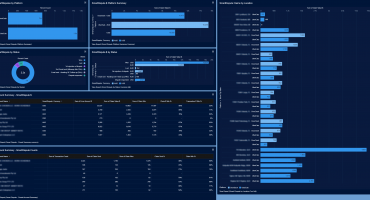In This article
There’s a lot of theft going on right now — in fact, theft numbers are 104.3% higher in 2023 than they were in 2019. So, trying to keep an eye on the areas of theft you can control, like time theft, is more important than ever.
However, time theft can be a complicated metric to track, let alone manage. Traditional theft, like stealing products, is black and white. Either an item was stolen, or it wasn’t. But how do you track time theft, something that’s much less obvious?
This article will equip you to handle time theft with ease. We’ll review what it is, what it looks like, and solutions to implement at your business that help you manage time theft.
What is Time Theft?
Time theft can sound confusing, but it’s literally the theft of paid time. This means that your staff, while being paid to do certain tasks, are either not doing the tasks they’re paid to do or doing tasks completely outside of their role.
If you want to think about the definition super simply, it’s your staff taking money from you for work they aren’t actually doing.
We’ll go over examples of this type of time theft in detail in a little bit.
Time theft can also include the literal theft of paid time. That means clocking staff members in before they arrive or clocking out later than they actually leave to earn from free paid time.
You also must consider instances where staff help each other get that bump to their paycheck for hours they never worked. Called “buddy punching”, this is when somebody gets their “buddy” to punch them in for a shift they aren’t working. It means they get free hours added to their check by stealing from your labor hours.
How Expensive is Time Theft?
An important thing to remember with time theft is that sometimes “time theft” happens without malicious intent. Sometimes things happen — there’s a car accident on the highway and one of your staff members is a few minutes late for a shift. Or there’s a sick child at home that has your manager check their phone a few extra times throughout their shift. A team member happens to end up serving an old friend and results in a longer-than-normal customer conversation.
The examples are endless, but the message is the same. Life happens, and you can’t expect your team to be working optimally at every second of every shift.
Time theft is expensive when it becomes the norm, not the exception, to a staff member’s behavior.
But how expensive?
The Cost of Time Theft
Let’s look at the average hourly wage in the United States. It currently sits at around $33.82/hour, or $1,163.41/week.
Now imagine you have a staff member named Marge. Marge has been on your team for the last three years, and does a good job when she’s focused.
But she’s almost five minutes late every single day.
Now five minutes may not seem like a huge deal, but let’s break down the math.
Say Marge works five shifts a week. If you use the $33.82/hour to do some math, that five minutes comes out to roughly $2.80. Seems like nothing, right?
But look at that throughout the five shifts a week. You’re suddenly up to $14.00 a week, which adds up to $56.00 a month, which adds up to over $670 a year.
And then consider time spent on your phone during shifts, smoke breaks, and chatting with staff. Even if that’s just 15 minutes of Marge’s day, there’s another $8.40 a day. And with some quick math, we’re looking at $2,016 a year.
Add tjhat to the late minutes, and that’s $2,686 a year spend on labor where nothing gets done.
And that’s just one employee and a relatively small instance that adds up day by day. Imagine 20 employees a year taking those “five minutes here and there”. You’re looking at $57,360 for 20 staff to be on the clock and getting nothing done.
Now add in different types of time theft or more intentional time theft and you’re going to be sinking a lot of money into labor costs that aren’t getting you anywhere.
What Does Time Theft Look Like?
Time theft can look different at every organization, but the general themes are the same. Your staff are on the clock, getting paid, but they aren’t doing the job you need them for.
Time theft can look like:
- Taking extended lunch breaks, beyond the paid allotment, and not properly clocking out
- Working on projects slower to earn overpay time that wasn’t necessary
- Taking naps at work
- Spending extended periods of time on your phone or device
- Socializing excessively with guests or friends to the point that it impacts your ability to get work done
- Buddy punching
- Opening and closing early or late, but still getting the paid labor hours
How Do You Minimize Time Theft? Seven Tips to Help
Since time theft can look so different, it can be hard to know exactly how to completely get rid of it. But at a minimum, there are some surefire techniques that help to minimize time theft.
Here are seven tips to minimize time theft at your businesses.
1. Set Clear Expectations
Your staff need to know what is expected of them at work — it’s not fair to assume they know.
Take the time to clearly define roles and responsibilities for each of your staff. This ranges from what they are expected to do while on the clock, to rules around breaks and clock outs. When your team understands what is expected of them, it’s easier for them to achieve it.
2. Establish Repercussions
Time theft can seem harmless to staff, so make sure that your team fully understands the repercussions for the business and for them individually.
For example, your team should know from the jump that participating in buddy punching results in being immediately let go. Losing your job can be a huge deterrent from bad behavior, like time theft.
3. Leverage Video Surveillance
Your video surveillance system can be a great way to keep an eye on time theft, even if you aren’t physically in store with eyes on the place.
Video surveillance allows you to keep an eye on how operations are going, and if your staff are working efficiently. You can see this through:
- Opening and closing alerts
- Labor reports via your video surveillance
- Review speed of service to ensure that your team is working efficiently, and therefore moving customers through the line efficiently as well
Having video surveillance in place also unlocks a new world of training opportunities! If you see that your team is struggling with closing, and it’s resulting in a ton of paid out overtime, you may want to revisit how you’re training your team for those responsibilities. Another example is if your team commits small offences, like extended breaks, and you can review the footage with them and chat about where to do better.
Pro tip: Leverage your video surveillance to keep an eye on phone usage. DTiQ’s SmartAudit™ gives you customized insights into phone use. Get stats on phone use within your staff emailed right to your inbox on a weekly or monthly basis, and use those findings to customize your goals.
4. Reward Productivity
It becomes easier to reward productivity once you have your video surveillance in place because you’re able to spot more moments of your staff getting it right.
As you review video footage, chances are there will be a lot of moments you catch your team doing well. This can be putting a phone in their locker, being diligent on their clock in/clock out time for breaks, or even reminding another teammate to come back from break so they aren’t late.
Take those opportunities to reward their productivity! It shows your team you appreciate what they’re doing, encouraging them to continue it, and can serve as an easy way to inspire the rest of your team to aim for the same thing.
Little rewards, like a small gift card, can go a long way in boosting morale.
5. Lead by Example
Trusting your management and higher leaders to lead by example is key when it comes to managing and minimizing time theft. After all, why should your team be off their phones and working if the management they look up to is on their devices constantly?
Leading by example also bleeds into areas like punctuality. Late managers inspire a late team!
6. Limit Device Use
The reality is people are glued to their devices (guilty!). Getting staff to completely give up their devices for eight hours can be near impossible, so set a realistic goal. This can look like deciding on certain areas in the business that phones can be used (out of customer eyesight!), and time limits. You can also encourage your staff to save phones for breaks.
7. Clear Breaks
Make sure breaks are communicated clearly and consistently on each day. Time theft can often be a result of poor communication, especially around breaks. If your team comes in and isn’t sure when they are meant to take a break, it can result in taking them on their own time and not for the proper amount of time.
Encourage your team to take breaks as scheduled and minimize the chance of them going rogue and planning their own break times.
Manage Time Theft with Ease
Time theft sounds daunting, but it doesn’t have to be. Armed with these techniques, you can minimize the cost while keeping your team happy and working hard.
Want to level up efforts when it comes to minimizing time theft? DTiQ can help. You can book a demo or get in touch today to see how we can measure and improve this key business metric — and ensure you’re only paying for hours worked.




























![The cost of doing business: Dealing with inflation [2024] The cost of doing business: Dealing with inflation [2024]](https://www.dtiq.com/wp-content/uploads/elementor/thumbs/66631ead75f0f32462c69b9d_665780298654d3767a08c91b_inflation-article-816-x-436-px-r2f390tr342tt3ydcevdg1f0j54rryld4pgka288r4.webp)

